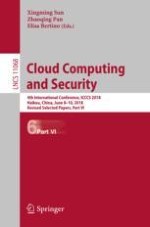This six volume set LNCS 11063 – 11068 constitutes the thoroughly refereed conference proceedings of the 4th International Conference on Cloud Computing and Security, ICCCS 2018, held in Haikou, China, in June 2018. The 386 full papers of these six volumes were carefully reviewed and selected from 1743 submissions. The papers cover ideas and achievements in the theory and practice of all areas of inventive systems which includes control, artificial intelligence, automation systems, computing systems, electrical and informative systems. The six volumes are arranged according to the subject areas as follows: cloud computing, cloud security, encryption, information hiding, IoT security, multimedia forensics
